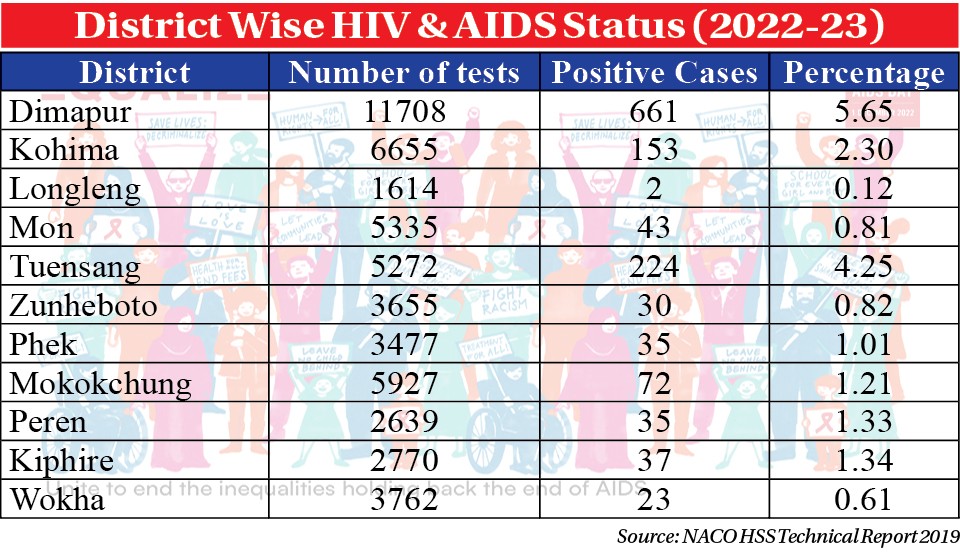
Need for revision of Policy
Atono Tsükrü Kense
Kohima | November 30
Thirty-two years since the first HIV and AIDS positive case was detected in the State, the prevalence of HIV and AIDS still remains a grave concern today.
With 1.44% (adult-15 to 49 yrs) of its population being infected, Nagaland has the second highest prevalence of HIV and AIDS, next to Mizoram with over 2.30% in India, as per the NACO HIV Estimation 2020.
General population prevalence rate in Nagaland stands at 1.66 % (NACO HSS Technical Report 2019). Among the districts, Dimapur has the highest prevalence with 5.65% followed by Tuensang with 4.25% and Kohima with 2.30%. (See box)
As per the data obtained from the Nagaland State AIDS Control Society (NSACS), from April till October 2022 a total of 1,315 positive cases were detected. Since 2006, a cumulative total of 31,152 cases were detected in the state. This deadly disease has so far claimed 2,619 lives till October 2022 (HIV related deaths on ART).
Another major area of concern is the prevalence of HIV among the children (under 14 years) with a total of 68, and a cumulative 1,298 cases since October 2007.
Sexual route most common transmission of HIV
Sharing grave concern on where the state stands in terms of HIV prevalence, Dr Akuo Sorhie, Project Director, Nagaland State AIDS Control Society (NSACS) told The Morung Express that “it is a matter of great concern for us.”
She also informed that currently, the highest percentage of HIV transmission is through sexual route, and that NSACS is trying to tackle this issue through various platforms.
According to Dr Sorhie said, some of the programmes that NSACS has initiated to mitigate this problem includes intensified Information, Education & Communication (IEC), 360 degree special communication campaign, and testing treatment.
Besides, to decrease the viral load among those who are on medicine, she said the patients are been encouraged and advised to take their medicine timely and regularly to the extent that they are no more transmissible through sexual route.
“We are trying to reach out to every areas of the state, even the border areas through many new innovative strategies to collect samples, give medicines and commodities wherever is needed.”
Need to revisit HIV & AIDS policy
Considering the high prevalence, Abou Mere, President of Network of Nagaland Drugs and AIDS Organisations (NNagaDAO) asserted that Nagaland needs to revisit Nagaland HIV and AIDS Policy. He underscored the need to adapt the policies to the current situation considering the emerging policies and guidelines issued by National AIDS Control Organisation (NACO) and HIV and AIDS (Prevention & Control) Act, 2017.
While recognising and applauding the leading role that NACO/NSACS and many development partners NGOs and CBOs played in compacting HIV and AIDS in Nagaland, he viewed that meaningful engagement with NGOs society and CBOs is unparalleled and fundamental for developing a robust HIV response.
Mere also asserted “the government of the day and political leaders should provide leadership which might strengthen the state HIV programme in mitigating and optimising the impact of HIV response in the state.”
Expressing concern over the gradual rise of practicing high risk behaviours among the young adolescents, he underscored the urgent need of political leadership and guidance to work with the development partners, NGOs and CBOs to tackle this emerging situation and prevent new HIV infection with a set of activities “tailored in our local context for today’s young adolescents and youth.”
On December 1, NSACS is observing the World AIDS Day under the theme ‘Equalize’ at Hotel Japfü at 11:00 am followed by a panel discussion with personalities from various backgrounds and professions.






